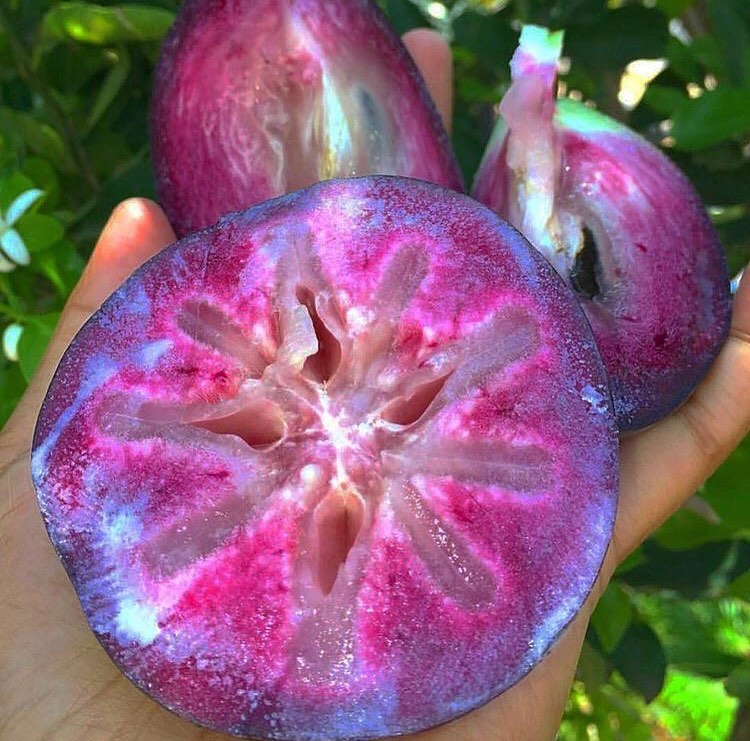The Jamaican star apple, scientifically known as Chrysophyllum cainito, is a captivating tropical fruit native to the Caribbean and Central American regions. Its distinct moniker stems from the remarkable star-shaped pattern revealed when the fruit is sliced crosswise, unveiling its core. This visually striking feature has bestowed upon it various other names, including “pomme du lait” (milk apple), milk fruit, caimito, and abiaba.
A Tropical Tree with Prolific Yields
Thriving in hot climates, the star apple tree can reach towering heights of 70 feet or more. However, these majestic trees only commence bearing fruit after a considerable wait of 5 to 6 years. Once mature, the star apple tree becomes a prolific producer, bearing an abundance of fruit during the season that spans from March to June.
Handpicked Treasures
Unlike many other fruit varieties, star apples stubbornly cling to their branches, refusing to fall even when fully ripened. As a result, harvesting these tropical gems requires a hands-on approach, with each fruit meticulously handpicked from the tree. This tenacious trait has earned the star apple a reputation as a “mean fruit” in Jamaican parlance, often used to describe someone who is reluctant to share or let go.
Varieties and Appearance
The Jamaican star apple comes in two distinct varieties, each adorned with its own unique hue. The first boasts a deep, alluring purple skin, while the second variety dons a verdant green exterior, even when fully ripened. Beneath these contrasting exteriors lies an equally diverse interior:
- The purple-skinned variety unveils a white pulp delicately tinged with lavender hues along its periphery.
- The green-skinned counterpart reveals an entirely white, creamy flesh.
Both varieties, however, share a common trait – a thick, inedible skin that must be peeled away to access the coveted flesh within.
A Taste of the Tropics
 The star apple’s flavor profile is a delightful fusion of tropical notes, often described as a harmonious blend of apple, persimmon, and lychee. Its aromatic flesh boasts a delicate sweetness, though the intensity of this sweetness can vary, with fewer seeds typically indicating a sweeter fruit.
The star apple’s flavor profile is a delightful fusion of tropical notes, often described as a harmonious blend of apple, persimmon, and lychee. Its aromatic flesh boasts a delicate sweetness, though the intensity of this sweetness can vary, with fewer seeds typically indicating a sweeter fruit.
While some may find the star apple’s inherent latex-like quality and mild sweetness less appealing, others relish its unique taste and texture. For those seeking a more pronounced sweetness, the purple-skinned variety is often considered the sweeter of the two.
A Culinary Canvas
Unlike in regions like India, where the star apple is incorporated into smoothies and various culinary creations, Jamaicans predominantly savor this tropical treat in its fresh, unadulterated form. The simplicity of enjoying a freshly picked star apple, peeled and consumed with a spoon, is a cherished tradition deeply rooted in the island’s culture.
Nutritional Powerhouse
Beyond its captivating appearance and delectable flavor, the star apple is a veritable nutritional powerhouse, brimming with an array of beneficial compounds. Its flesh is a rich source of antioxidants, aiding in the fight against free radicals and lending anti-inflammatory properties.
Moreover, this tropical delight is an excellent source of vitamin C, calcium, and phosphorus, contributing to a well-rounded diet. Its seeds, when properly prepared, have been traditionally employed as a natural tonic, diuretic, and fever reducer, further underscoring the star apple’s multifaceted health benefits.
A Storied Journey Through Time and Lands
The star apple’s history is as rich and captivating as its flavor. Its origins can be traced back to the 16th century when Spanish explorer Cieza de Leon first encountered it growing in Peru. From there, this remarkable fruit embarked on a global odyssey, finding its way to the Caribbean, Guatemala, India, Panama, the Philippines, and Zanzibar.
In the late 1800s, the United States began cultivating star apples, first in Florida and later in Hawaii, after obtaining seeds from Jamaica. This widespread dissemination not only facilitated the star apple’s introduction to new lands but also contributed to its diverse array of names and cultural associations.
Elusive Availability and Prized Qualities
Despite its alluring qualities, the star apple remains an elusive find in conventional supermarkets, often gracing the shelves of specialty health food stores instead. This scarcity only adds to the fruit’s mystique and desirability, as those seeking its unique flavors and health benefits must actively seek it out.
Furthermore, the star apple’s rarity is compounded by its tropical growing requirements, limiting its cultivation to regions with suitable climates. This exclusivity has only served to heighten the star apple’s allure, rendering it a prized delicacy cherished by those fortunate enough to experience its enchanting taste and textures.
A Childhood Delight and Nostalgic Memories
For countless Jamaican children, the star apple holds a special place in their hearts, evoking fond memories of carefree days spent beneath the shade of its towering trees. The simple act of plucking a ripe star apple from its branch and savoring its sweet, milky flesh has become an indelible part of the island’s cultural tapestry.
These nostalgic recollections are often tinged with a touch of whimsy, as children would revel in the star apple’s refusal to fall, perceiving it as a stubborn yet endearing trait. Such cherished memories have only deepened the star apple’s connection to Jamaican heritage, ensuring its enduring place in the collective consciousness of generations to come.
A Global Embrace and Enduring Legacy
While the star apple may have originated in the tropical climes of the Americas, its allure has transcended borders and cultures. In Spain, it is affectionately known as the caimito maduraverde, while the French refer to it as the golden-leaf tree. Portugal, too, has embraced this exotic fruit, calling it ajara and caimito.
This global embrace not only attests to the star apple’s universal appeal but also serves as a testament to its enduring legacy. As it continues to captivate palates and imaginations around the world, the Jamaican star apple stands as a symbol of the island’s rich culinary heritage, a delectable ambassador that bridges cultures and celebrates the diversity of flavors our world has to offer.
For recommendations on some of the best times to visit Jamaica, you can check out our guide here.
—
If you’re traveling to Jamaica alone, ensure you take all the necessary measures to keep safe. Read about how you can stay safe while visiting Jamaica. If you decide to visit any resort, be sure to tag us in your photos and videos @resortcaribbean, and follow our socials: Instagram, Facebook, YouTube.







![What You Need to Know before Visiting Azul Beach Resort Negril Jamaica Gourmet All-Inclusive [Resort Review] Azul Beach Resort Pool](https://resortcaribbean.co/wp-content/uploads/2021/09/20210828_091210-2-100x70.jpg)
![Visiting Ocean Coral Spring – One of Jamaica’s Most Famous Resorts [Resort Review] Visiting Ocean Coral Spring - One of Jamaica's Most Famous Resorts](https://resortcaribbean.co/wp-content/uploads/2021/11/20211106_155809-scaled-e1716408051807-100x70.jpg)
[…] About the Jamaican Star Apple […]